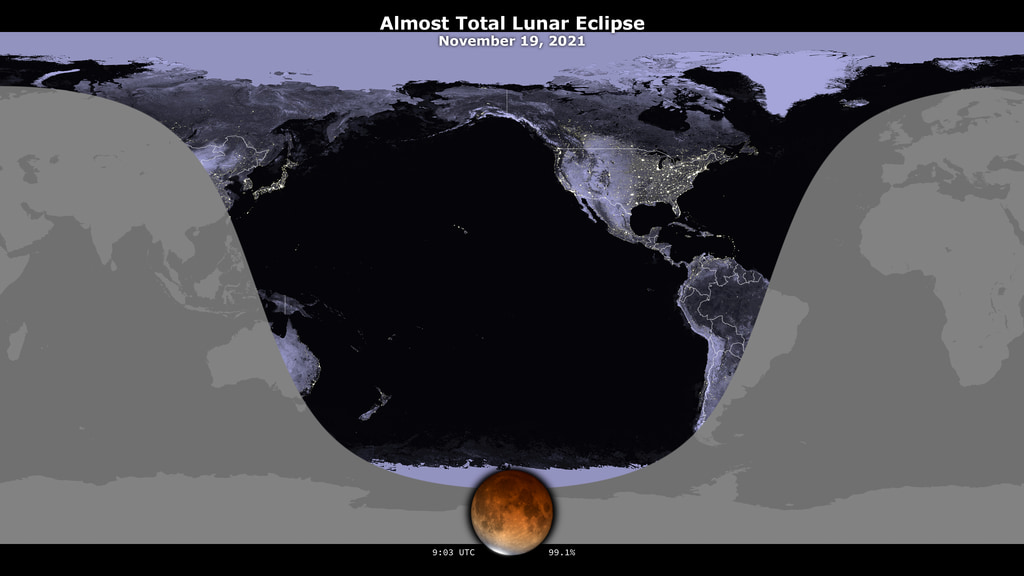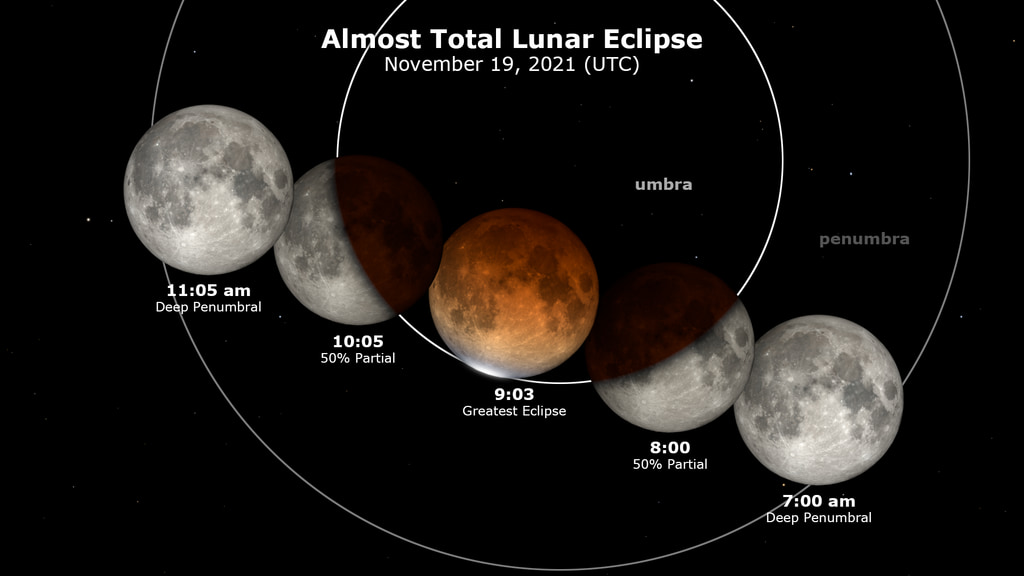The Beaver Moon partial lunar eclipse on Nov. 19 will be the longest of the century. Here are its stages explained.
Its peak will last 3 hours, 28 minutes and 23 seconds.
Update for 6:20 am ET: The Beaver Moon partial lunar eclipse has ended. Our wrap story with videos is here. You can check out amazing photos of the Beaver Moon lunar eclipse in our gallery.
The next eclipse of the moon will greet early risers before dawn on Friday morning (Nov. 19) across North America.
It will be the second lunar eclipse of 2021 and, in some ways, will be similar to the last one on May 26. Most North Americans will again need to get up early and look low in the west toward daybreak. And again, the farther west you are the better, as the moon will appear much higher from the western part of the continent as opposed to locations farther to the east. It will also be the longest partial lunar eclipse in 580 years, lasting just over 6 hours, with its pass through the darkest part of Earth's shadow taking about 3 hours, 28 minutes and 23 seconds, and also the longest this century.
But in another way, it will be different. This lunar eclipse will fall just shy of being total; 97.4% of the moon's diameter will become immersed in the Earth's dark umbral shadow at maximum eclipse, leaving just the southernmost limb ever-so-slightly beyond the outer edge of the umbra.
You'll be able to watch the Beaver moon lunar eclipse online here and on the Space.com homepage. The webcasts begin at 1:02 a.m. EST (0602 GMT).
- What time is the Beaver Moon lunar eclipse?
- How to watch the Beaver Moon eclipse online
- Beaver Moon lunar eclipse 2021: When and how to see it on Nov. 19
To those watching with the naked eye, binoculars and small telescopes, the lower edge of the moon will likely remain much brighter than the deep red or ochre hue we can expect across the rest of the moon's face.
To prepare for the Beaver Moon lunar eclipse of 2021, check out our guide on how to photograph the moon with a camera. If you need imaging gear, consider our best cameras for astrophotography and best lenses for astrophotography to make sure you're ready for the next eclipse.
Breaking space news, the latest updates on rocket launches, skywatching events and more!
Studying the diagram and map courtesy of Fred Espenak's Eclipsewise.com, along with our timetable, tells what to expect at your location and when. As you watch the progress of the eclipse it appears that the Earth's shadow is creeping across the moon's face. But as you can see from the diagram, it's really the moon that is doing the creeping. As it moves in its orbit around the Earth, the moon moves from west to east (right to left) through the Earth's shadow. The Mercator map shows that those near the West Coast will see the maximum phase of the eclipse happen high in a dark sky long before sunrise. Skywatchers farther east will find the moon sinking lower toward the west around mid-eclipse.
If you're in Hawaii, the eclipse happens deep in the night and nearly overhead. For New Zealand, Australia, Japan, China and Southeast Asia, it comes on the evening of Nov. 19 local date.
Related: Amazing photos of the Super Flower Blood Moon of 2021
| Event | EST | CST | MST | PST |
|---|---|---|---|---|
| Moon enters penumbra | 1:02 a.m. | 12:02 a.m. | *11:02 p.m. | *10:02 p.m. |
| Penumbra first visible? | 1:54 a.m. | 12:54 a.m. | *11:54 p.m. | *10:54 p.m. |
| Moon enters umbra | 2:18 a.m. | 1:18 a.m. | 12:18 a.m. | *11:18 p.m. |
| Mid-eclipse | 4:02 a.m. | 3:02 a.m. | 2:02 a.m. | 1:02 a.m. |
| Moon leaves umbra | 5:47 a.m. | 4:47 a.m. | 3:47 a.m. | 2:47 a.m. |
| Penumbra last visible? | 6:10 a.m. | 5:10 a.m. | 4:10 a.m. | 3:10 a.m. |
| Moon leaves penumbra | 7:03 a.m. | 6:03 a.m. | 5:03 a.m. | 4:03 a.m. |
*Times listed with an asterisk denote times prior to midnight; the corresponding calendar date is Nov. 18.
Because the moon will arrive at apogee — the farthest point in its orbit from Earth — on Nov. 20, it will also be moving at its slowest speed in its orbit. That's why it will seem to move at an almost "leisurely pace" through the Earth's shadow, taking over 100 minutes from the time of first umbral contact to the time of greatest eclipse, and vice versa (greatest eclipse to last umbral contact).
Phases of the eclipse
This eclipse will occur in five phases, with different things to watch for at each.
Phase 1: "Moon enters penumbra" is when the moon's leading edge enters the pale outer fringe of Earth's shadow: the penumbra. But the shadow is so weak that most people won't see anything of the penumbra until about 70% of the moon's diameter is inside of it. Watch for a slight darkening to become apparent on the moon's celestial southeast (lower left) side. The penumbral shading gradually becomes more evident as the moon moves deeper in.
Phase 2: "Moon enters umbra" marks the beginning of the partial eclipse. This will be a much more obvious and dramatic sight as the moon's leading-edge slips into the umbra, where no direct sunlight reaches. With a telescope, watch as the umbra's edge engulfs various lunar features such as craters, mountains and valleys.
And as the moon wanes to a crescent, be sure to take a look around the sky. Before the eclipse began, the sky was bright; the moon acting like a spotlight obliterating all but the brightest stars. But as the moon becomes more and more diminished, you'll begin seeing more and more of the fainter stars. At maximum eclipse, the moon could appear nearly 10,000 times dimmer than before the eclipse began. One object that will certainly stand out during the darkest phase of the eclipse will be the famous Pleiades star cluster which will be positioned about a half dozen degrees above and slightly to the right of the moon.
Phase 3: "Maximum eclipse" will be when just a final bright arc remains on the moon's lower rim, while the rest of the moon is showing a foreboding reddish glow. This ruddy coloration shining onto the moon is sunlight that has skimmed and bent through the Earth's atmosphere; the combined light of all the sunrises and sunsets that ring our world at this particular moment. If an astronaut were on the lunar surface. He or she would see the sun hidden behind a dark Earth ringed with a thin, brilliant band of reddish or orange-yellow light. If our hypothetical astronaut were located on the moon's southernmost regions, however, a narrow edge of the sun would be evident along the dark edge of the Earth. At this time, 97.4% of the moon will be immersed in the Earth's dark shadow.
Dark or bright?
The mainstream media has come to refer to a total (or in this case, almost total) lunar eclipse as a "blood moon" because the moon's tendency to glow a ruddy color at maximum eclipse.
But this is not always so.
Two factors affect a lunar eclipse's color and brightness. The first is how deeply the moon penetrates into the umbra; the umbra's center is much darker compared to its edge. The other factor is the state of the Earth's atmosphere along the sunrise/sunset line. If the air is very clear, the eclipse is bright with shades of reddish copper or orange, almost like a shiny new penny. But in the aftermath of a major volcanic eruption, the stratosphere, about 30 miles (50 km) high, becomes polluted with an aerosol cloud — a thin global haze — causing the moon to appear more similar to a chocolate brown, ashen gray, or on rare occasions (as was the case in 1963 and 1992) almost totally black.
In addition, look carefully near the moon's south rim for tinges of blue that is slightly refracted through, and tinted by, Earth's ozone-rich upper atmosphere.
Final phases
Phase 4: "Moon leaves umbra." After the partial eclipse attains its maximum and as the moon continues eastward along its orbit, events replay in reverse sequence.
Phase 5: "Moon leaves penumbra." When the last scallop of the Earth's umbra exits the moon's disk, only the last, penumbral shading is left. By about 25 minutes later, nothing unusual remains at all and our November full moon appears as bright as ever.
If it's cloudy, North Americans won't have to wait long for more lunar eclipses. In 2022 there will be two total eclipses, the first coming on May 15-16 and the second occurring on Nov. 8. Both will be visible across much of North America, with the first coming during "prime-time" evening-to-midnight hours, while the second takes place (again) during the early hours of the morning; moonset and sunrise will interrupt the latter stages for those living in the East. Interestingly, in both cases the duration of totality will be the same, lasting 85 minutes.
Joe Rao serves as an instructor and guest lecturer at New York's Hayden Planetarium. He writes about astronomy for Natural History magazine, the Farmers' Almanac and other publications. Follow us on Twitter @Spacedotcom and on Facebook.

Joe Rao is Space.com's skywatching columnist, as well as a veteran meteorologist and eclipse chaser who also serves as an instructor and guest lecturer at New York's Hayden Planetarium. He writes about astronomy for Natural History magazine, Sky & Telescope and other publications. Joe is an 8-time Emmy-nominated meteorologist who served the Putnam Valley region of New York for over 21 years. You can find him on Twitter and YouTube tracking lunar and solar eclipses, meteor showers and more. To find out Joe's latest project, visit him on Twitter.


